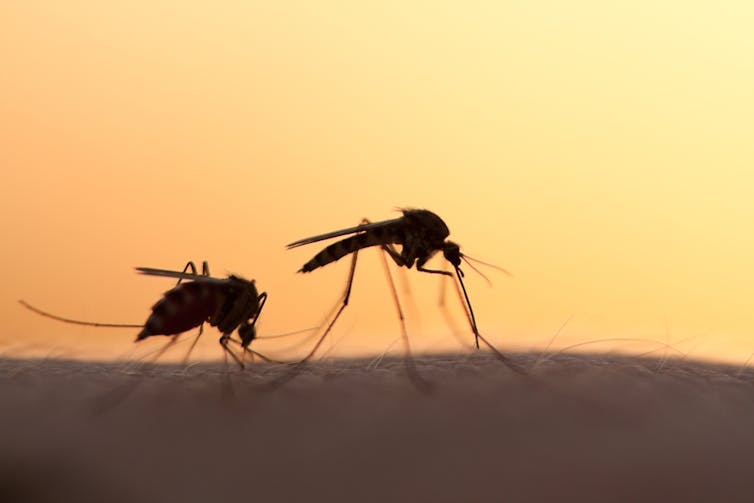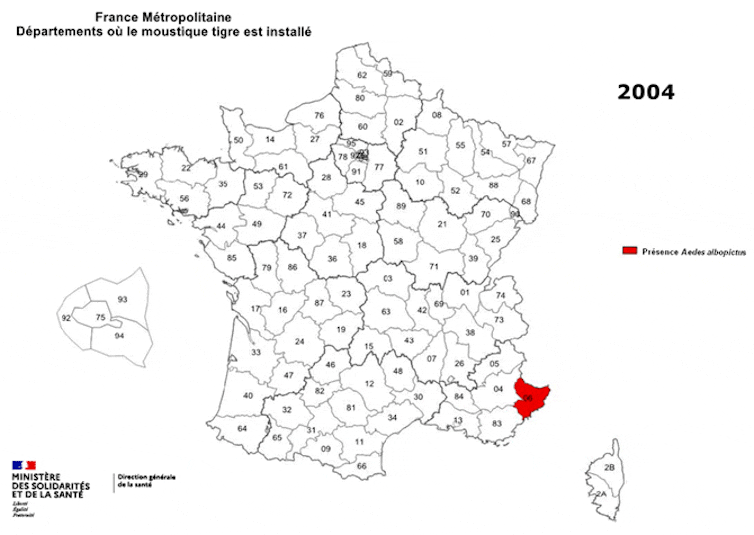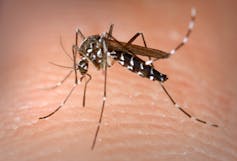Exotic" viruses in France: more topical than ever
Usutu virus, Zika virus, chikungunya virus, dengue virus... In recent years, these exotic-sounding names have all found their way into the French media. And with good reason: these viruses, responsible for diseases that until now have been confined to remote regions, are now moving out of the regions where they have long been endemic to conquer our planet. France is not immune to this threat, neither in overseas territories nor in mainland France, as witnessed by the current establishment of dengue and Usutu viruses around the Mediterranean arc. Which viruses should we be on the lookout for? What's the current situation? Here's what we've learned in recent years from the work of the surveillance networks currently in place and the research laboratories studying these viruses.
Yannick Simonin, University of Montpellier

Diseases transmitted from animals to humans
Many emerging infectious diseases are transmitted to humans via a "vector" animal, often a blood-sucking arthropod such as a mosquito, culicoides midge, sandfly or tick.
In such a case, if the disease is caused by a virus, it is referred to as "arbovirosis", and the virus involved is described as an "arbovirus" (from the English "arthropod-borne virus", "virus transmitted by arthropods"). Since 2015, the World Health Organization (WHO) has drawn up an annual list of priority diseases. Updated in 2021, this list features only viral diseases. Among the 9 listed are 3 arboviroses: Zika virus disease, Crimean-Congo hemorrhagic fever, Rift Valley fever.
It's also important to remember that most arboviroses are zoonoses. In other words, they initially come from domestic or wild animals carrying the disease agent. The agent is then transmitted to humans, when the latter are bitten by an arthropod vector that has previously drawn blood from an infected animal.
What happens next depends on the arbovirus transmitted. Some can pass from one human being to another, always via a vector. Others may spread in parallel via other modes of transmission (the Zika virus can be transmitted by mosquitoes and sexually, for example). Some arboviruses cannot be transmitted between human beings: in this case, humans are said to be an "epidemiological dead end". This is the case, for example, with the West Nile virus or the Rift Valley virus.
Mosquitoes, and in particular the tiger mosquito(Aedes albopictus), are key players in the spread of arboviroses. The tiger mosquito recently arrived in France, and has quickly established itself. The tiger mosquito alone is capable of spreading several "exotic" viruses.
[Nearly 70,000 readers trust The Conversation newsletter to better understand the world's major issues. Subscribe today]
The tiger mosquito continues its meteoric rise
Catalyzed by international trade, the expansion of the tiger mosquito (Aedes albopictus), vector of several "exotic" viruses, has been very rapid.
Originally from Asia, this small black mosquito with white-striped body and legs was first detected in the south of France in 2004, in Menton. Less than twenty years later, it is present in 67 of France's 96 départements (compared with 58 in 2020). In the years to come, its territory will continue to expand inexorably.

Ministry of Solidarity and Health - Health Department
One of the mosquito's particularities is its ability to transmit various disease-causing viruses, the best known of which are probably the Zika, chikungunya and dengue viruses.
Dengue: an upward trend in native cases
The dengue virus seems to have found a suitable playground in the southern regions of our country. Although the number of cases of dengue fever in mainland France remains limited, estimated at less than thirty in recent years, the upward trend is nevertheless confirmed.
This is evidenced by the increasing number of so-called "native" cases, meaning that the disease was contracted in France, as opposed to imported infections, which occur in France but are contracted abroad during travel. Departments in the south and south-east of France, such as Hérault, Gard, Var and Alpes-Maritimes, are the most exposed to the disease, notably due to the combination of a high density of tiger mosquitoes and highly urbanized areas.

Wikimedia Commons / Centers for Disease Control and Prevention
Given that dengue is largely asymptomatic (in 50% to 90% of cases, depending on the epidemic), and that in symptomatic people, the symptoms of the disease (fever, headaches, muscle aches, etc.) can easily be confused with those of influenza or, more recently, Covid, the number of cases is certainly greatly underestimated.
Although the disease it causes is generally benign, the dengue virus can nevertheless lead to a potentially fatal form of the disease in around 1% of cases: so-called "hemorrhagic" dengue, as it is accompanied by bleeding in multiple organs. Neurological damage has also been reported.
Chikungunya keeps a low profile
First identified in Tanzania in 1952, the chikungunya virus circulated for several decades in Africa, India and Asia, as well as in the Indian Ocean. In fact, it was the epidemic that struck Réunion, Mauritius, Mayotte and the Seychelles in 2005 that helped bring it to the attention of the French public.
The "bent man's disease" (a possible translation of "chikungunya", a term derived from Makonde, the Bantu language spoken in Tanzania) is characterized by fever and severe joint pain. Highly incapacitating, the latter often affect the hands, wrists, ankles or feet. Headaches and muscle pain, as well as bleeding from the gums or nose, have also been frequently described. Convalescence may last several weeks, and pain may persist for several years.
The first two native cases of chikungunya were detected in France in 2010, in the Var region. Since then, some 30 native cases have been recorded, including two major outbreaks, one in the city of Montpellier in 2014 (11 confirmed cases and 1 probable case) and the second in the Var in 2017, with 17 cases recorded.
The chikungunya virus has been keeping a low profile in France in recent years, with 3 imported cases in 2021 and 5 in the current year, according to Santé publique France. However, the virus remains under close surveillance, not least because its spread by the tiger mosquito in temperate European regions cannot be ruled out.
In anticipation of a re-emergence of the Zika virus
The Zika virus made headlines in 2015-2016. It was the cause of a very large-scale epidemic, mainly in Latin America. More than a million people were infected. The most serious damage associated with this virus is the development of microcephaly (reduced fetal head circumference) in infected pregnant women.
In France, two autochthonous cases were identified in 2019, in the Var département, without it being possible to clearly establish the transmission chains, particularly vector-borne.
Still on the World Health Organization's list of the 10 highest-risk diseases, this virus has mysteriously all but disappeared from the radar in recent years. However, its return to the viral limelight is far from out of the question: it recently made the news again in Thailand, and 5 travellers developed the disease in Germany, the UK and Israel, after visiting this South-East Asian country.
Although little is known about the mechanisms favoring the emergence of the Zika virus, seroprevalence studies (presence of antibodies in the blood) show that it is still actively circulating in certain territories(particularly on the African continent).
Its monitoring requires particular vigilance on the part of the scientific community, in order to prepare for a potential reappearance.
Good old Culex is not to be outdone
One of our "traditional" mosquitoes, Culex pipiens, present throughout France, is also capable of transmitting "exotic" viruses. These include the West Nile and Usutu viruses, two closely related viruses that can occasionally cause severe neurological disorders such as encephalitis (inflammation of the brain), meningitis (inflammation of the meninges) or meningoencephalitis (inflammation of the meninges and brain) in humans.
A study carried out by our team and published in 2022, in collaboration with Anses and CIRAD, has shown that these two viruses are becoming established in certain areas of France, particularly in the Camargue region. They are regularly found not only in human blood samples, but also in animals such as birds (their natural reservoirs), dogs, horses and mosquitoes.
So far, their impact on human health remains low: a single Usutu virus infection has so far been identified in France, in Montpellier, while some thirty cases of West Nile have been reported over the last five years. Nevertheless, it is important to monitor the dynamics of the spread of these viruses, as several lineages with varying degrees of virulence are currently circulating, prompting caution. Especially since a major epidemic hit Europe in 2018, with over 2,000 cases identified and more than 180 deaths reported.
In addition, Italy - like other southern European countries - reported early circulation of the West Nile virus this year, with almost 150 cases identified by mid-August, revealing an increasingly permanent presence in the south of the continent.
Human activities and emergences
The transition of a disease from animal to human is not necessarily synonymous with an outbreak, a large-scale epidemic, a pandemic or the introduction of a disease into new territories. In fact, these types of events are the result of a combination of events.
The problem is that trade and tourism, which are growing exponentially in our hyper-connected world, can facilitate the dissemination of certain vectors and thus the risk of spreading disease.
This risk is further increased by environmental and climatic changes. Weather conditions, particularly temperature, humidity and rainfall, affect the geographical distribution, activity, reproduction rate and survival of vectors, especially mosquitoes. In addition, changes in climate and the impact of human beings on their environment sometimes influence animal behavior, for example by modifying the range of certain species, which can encourage interactions between animals and humans.
Such environmental changes have been responsible for epidemics of Argentine hemorrhagic fever, caused by the Junin virus. In the 1950s, massive land clearing was carried out to intensify corn cultivation, in particular through the use of herbicides. This change in environment led to a proliferation of rodents, some of which carried the virus, causing the disease to reach epidemic proportions, particularly among farm workers. Thousands of people became infected. A similar situation was observed in East Asia when land was converted to rice cultivation, with the Hantaan virus responsible for "Korean hemorrhagic fever".
Other factors favoring the emergence of new diseases include socio-economic factors, such as the increase in the transport of goods and people, notably via intercontinental air transport, and the ever-growing expansion of urban areas. High population densities, which encourage the rapid transmission of disease, and the water supply difficulties associated with rapid urbanization, contribute to the proliferation of potentially virus-carrying mosquitoes.
Proof of the importance of these factors is that, during the Covid-19 pandemic, the number of cases of "exotic" imported infections (i.e. brought back from travel) fell considerably, mainly due to the drastic drop in international air travel. With the marked upturn in such traffic, however, an increase in such cases is expected this year.
This situation could have an impact on the emergence of outbreaks in France, as an infected person arriving on our territory can in turn transmit the disease to others, particularly if the vectors transmitting the disease are present.
Prevention, the first weapon against "exotic" viruses
In the absence of an effective antiviral or vaccine, as in the case of chikungunya or Zika, or when the vaccine has certain limitations (as in the case of dengue fever, against which the only currently licensed vaccine has the disadvantage of increasing the risk of hospitalization and severe dengue fever in people not previously infected with the dengue virus), the only solution is to anticipate the emergence of these pathogens.
The best way to achieve this is to set up appropriate, responsive networks, as close to the field as possible, in order to effectively study the interactions between animals, humans and their various environments, according to an approach described as " One Health" (human and environmental).
Since the Covid-19 pandemic, national and international viral disease surveillance networks have expanded. Unfortunately, their capacities still fall far short of what is needed to effectively monitor the circulation of high-risk viruses, not only in endemic countries, but also in countries where they are emerging.
The emergence and rapid spread in 2020 of the SARS-CoV-2 coronavirus, responsible for the Covid-19 pandemic, has had a major impact on our health, our behavior and our daily lives. This situation has made us brutally aware of the importance of monitoring and studying "new" viruses.
But beyond these "new" viruses, it's also essential to look at "neglected" viruses responsible for diseases that occur far from our borders.
Propagation outside Africaand particularly in Europe, from Monkeypoxthe virus responsible for [monkeypox], is a good illustration of the stakes involved in such surveillance...![]()
Yannick Simonin, Virologist, lecturer in surveillance and study of emerging diseases, University of Montpellier
This article is republished from The Conversation under a Creative Commons license. Read theoriginal article.